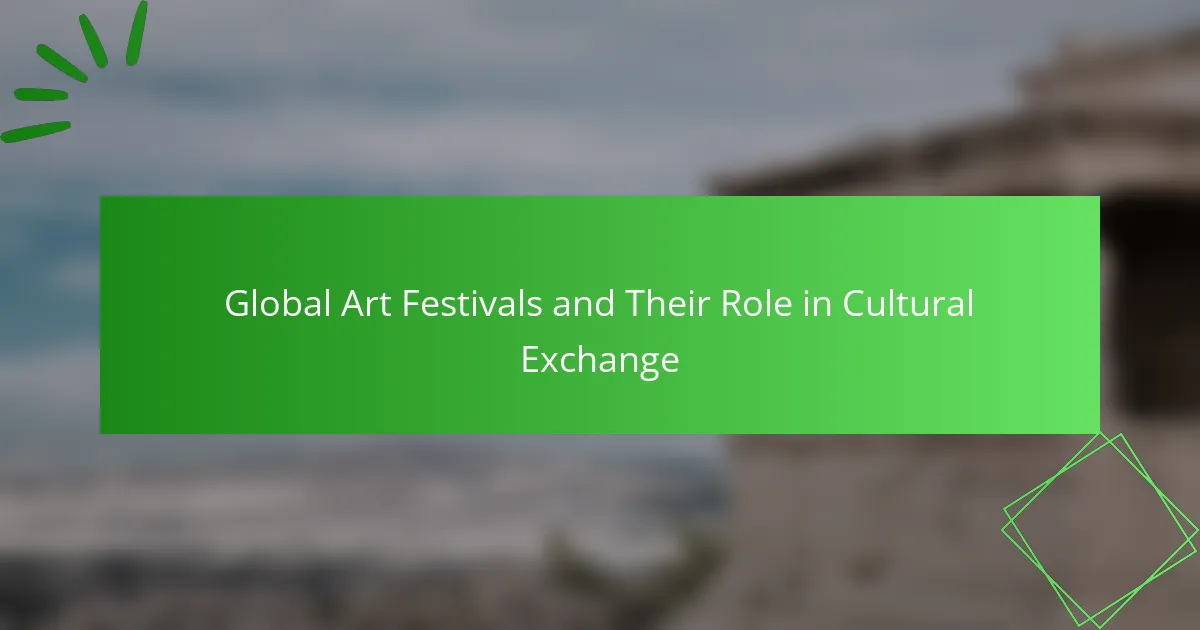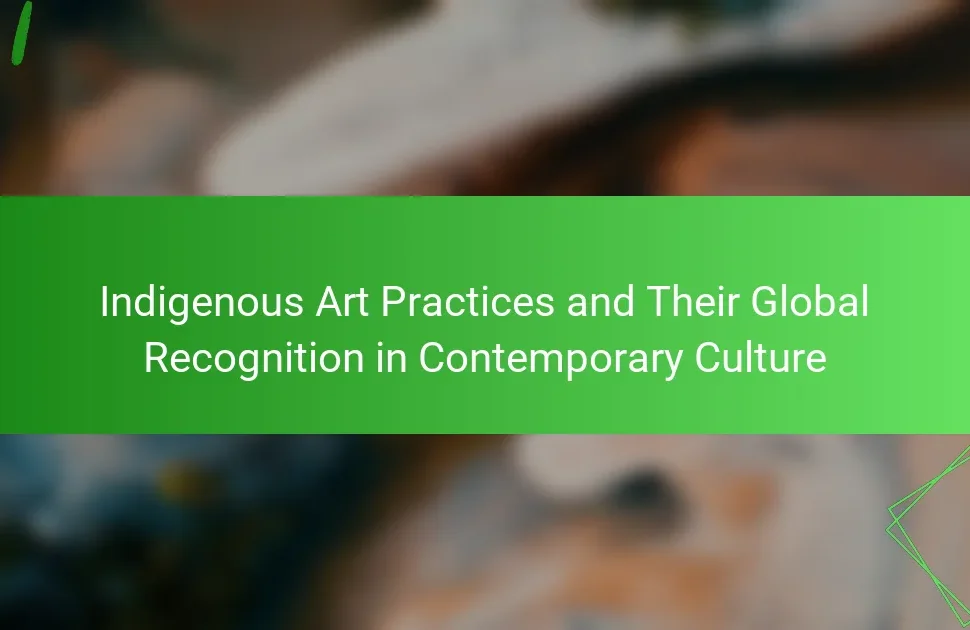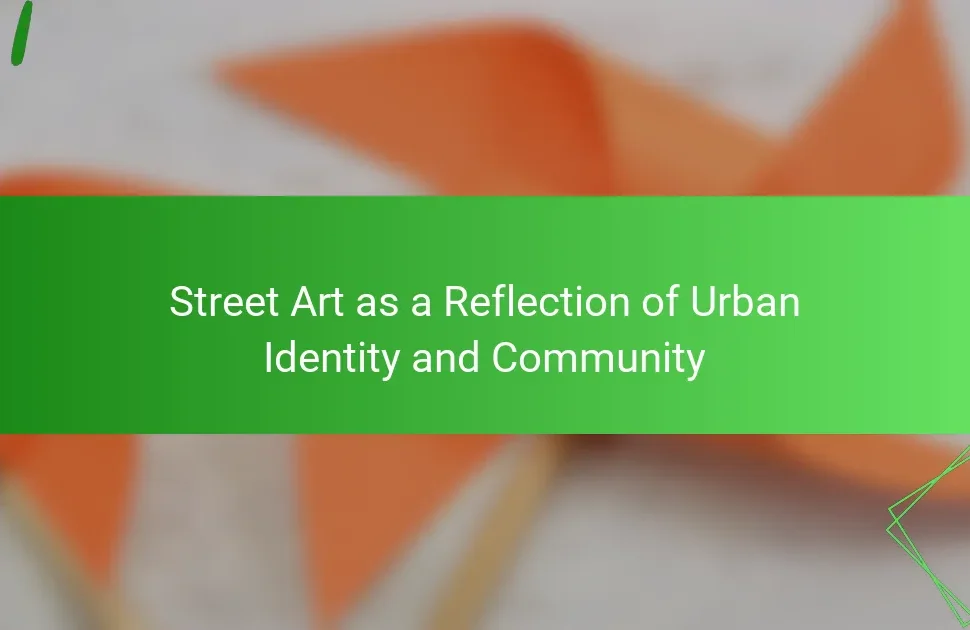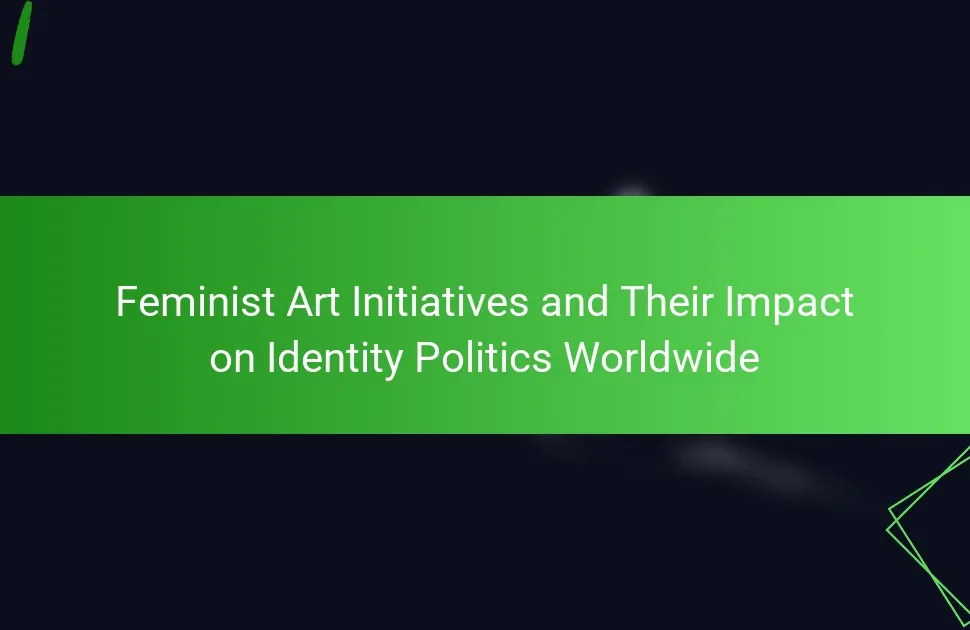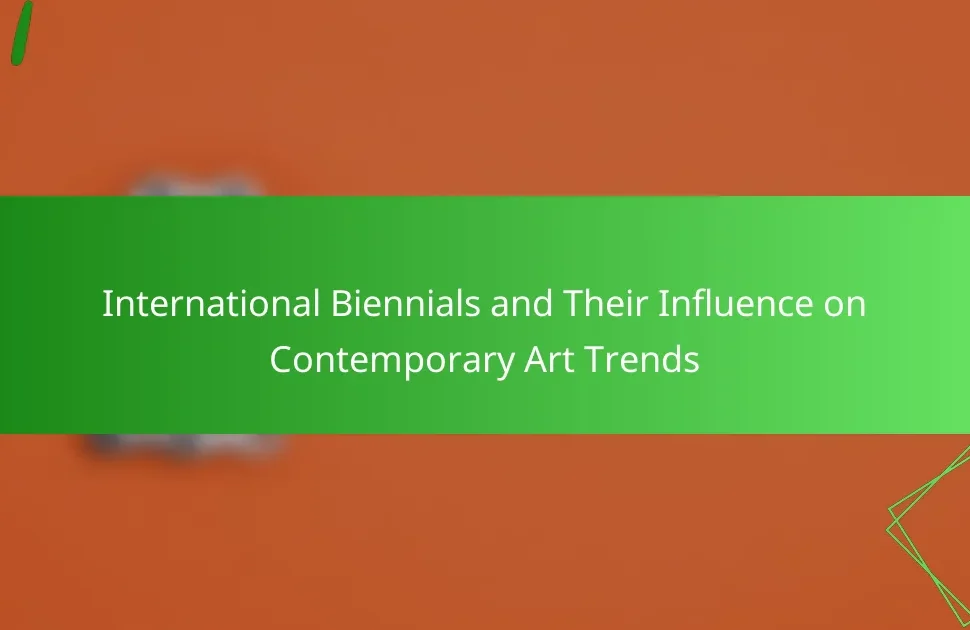Global art festivals play a vital role in promoting cultural exchange and fostering community engagement. They showcase diverse artistic expressions, highlight unique cultural identities, and encourage dialogue on global issues. These festivals face challenges such as funding, cultural appropriation, and sustainability, while also embracing technology to enhance accessibility and participation. Notable examples like the Venice Biennale and Edinburgh Festival illustrate the impact of these events on cultural connectivity.
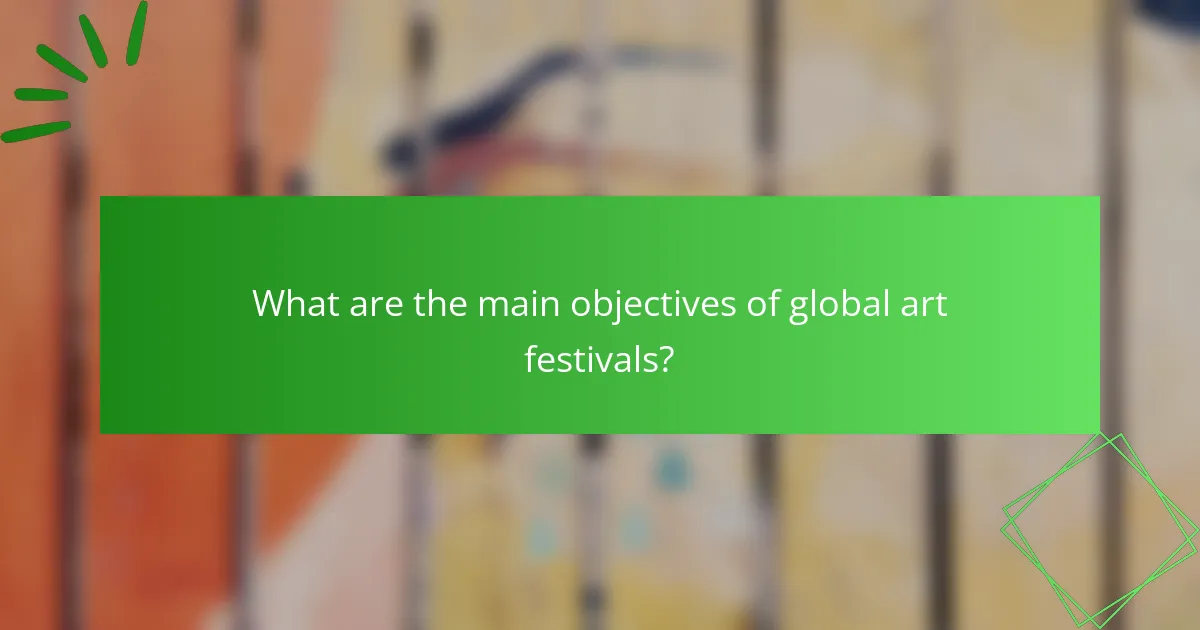
What are the main objectives of global art festivals?
Global art festivals aim to promote cultural exchange, showcase diverse artistic expressions, and foster community engagement. They create platforms for artists to connect with audiences and facilitate dialogue on global issues. These festivals often emphasize collaboration, innovation, and the celebration of cultural heritage. By attracting international visitors, they enhance tourism and stimulate local economies.
How do art festivals promote cultural exchange?
Global art festivals promote cultural exchange by facilitating interactions among diverse artists and audiences. These events showcase various artistic expressions, encouraging dialogue and collaboration. They highlight unique cultural narratives, fostering mutual understanding and appreciation. Furthermore, art festivals often feature workshops and discussions, allowing participants to share skills and ideas, enhancing cross-cultural connections.
Which communities benefit most from participation in art festivals?
Communities that benefit most from participation in art festivals include local artists, cultural organizations, and tourism-dependent areas. Local artists gain exposure and networking opportunities, enhancing their careers. Cultural organizations foster community pride and cultural exchange. Tourism-dependent areas see increased economic activity and visitor engagement, boosting local businesses.
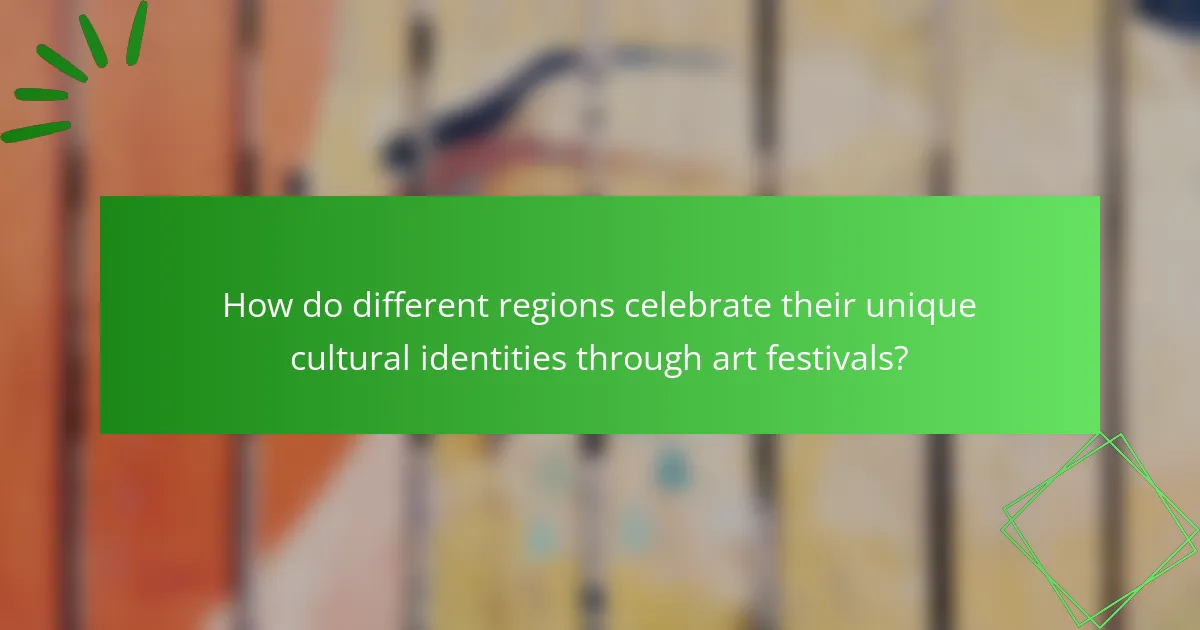
How do different regions celebrate their unique cultural identities through art festivals?
Different regions celebrate their unique cultural identities through art festivals by showcasing local traditions, art forms, and community values. These festivals serve as platforms for cultural exchange and understanding.
For instance, the Rio Carnival in Brazil emphasizes vibrant parades and samba music, reflecting the country’s diverse heritage. Meanwhile, the Edinburgh Festival Fringe in Scotland highlights theater and performance art, showcasing global artistic talents.
Art festivals also foster community pride and engagement. The Venice Biennale in Italy not only displays contemporary art but also encourages international dialogue among artists. Similarly, the Diwali Festival in India integrates traditional crafts and performances, celebrating cultural unity.
These events play a crucial role in preserving cultural heritage while promoting innovation in the arts. By participating in such festivals, communities reinforce their identities and share their unique stories with the world.
What role do local traditions play in shaping festival themes?
Local traditions significantly influence festival themes by embedding cultural narratives and values into celebrations. These traditions serve as a foundation for artistic expression, allowing communities to showcase their unique identities. For instance, festivals often feature local music, dance, and cuisine, reflecting historical practices and communal stories. As a result, global art festivals become a platform for cultural exchange, fostering appreciation and understanding among diverse audiences. This interplay between tradition and contemporary art enhances the richness of the festival experience, creating a vibrant tapestry of cultural dialogue.
How are global art festivals influenced by regional artistic styles?
Global art festivals are significantly influenced by regional artistic styles, showcasing local traditions and techniques. These festivals facilitate cultural exchange by bringing diverse artistic expressions into a global context. For instance, festivals often feature local artists, allowing them to present their unique perspectives and practices to international audiences. This interaction fosters appreciation and understanding of different cultures, enriching the global art scene. Additionally, the incorporation of regional styles can lead to innovative collaborations, blending traditional and contemporary art forms. Through this dynamic exchange, global art festivals become platforms for dialogue, creativity, and cultural preservation.
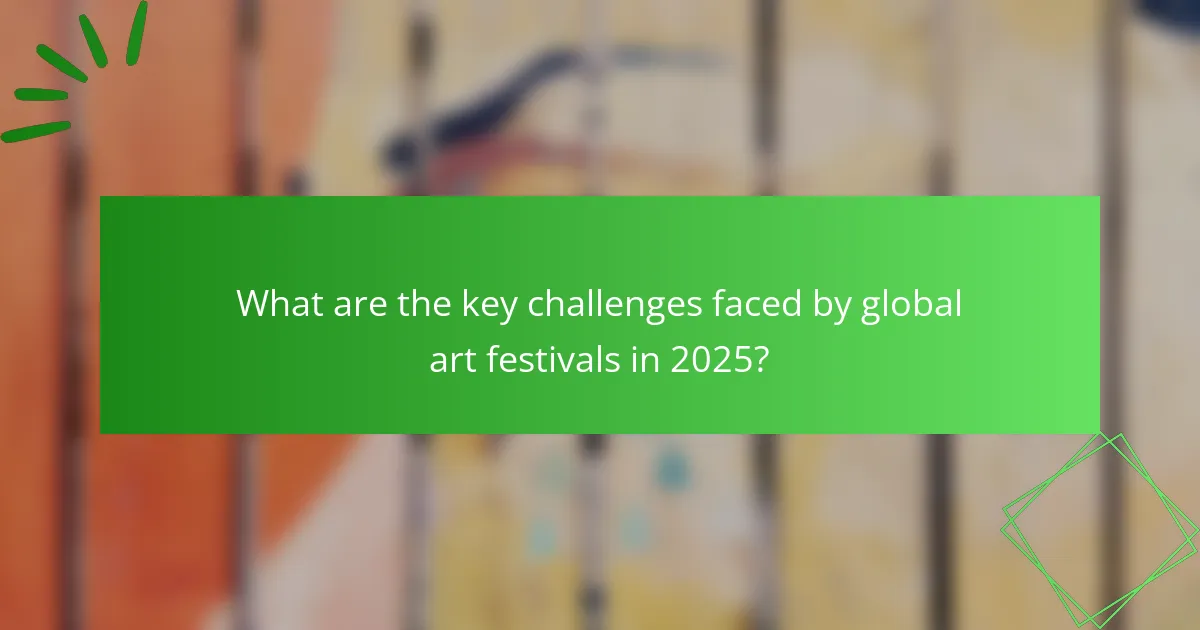
What are the key challenges faced by global art festivals in 2025?
Global art festivals in 2025 face challenges such as funding issues, cultural appropriation debates, and sustainability concerns. These factors impact their ability to promote cultural exchange effectively.
Funding remains a critical challenge, with many festivals relying on sponsorships and grants that may fluctuate. Cultural appropriation raises questions about representation and authenticity, complicating programming decisions. Sustainability concerns arise from the environmental impact of large events, pushing festivals to adopt greener practices.
Additionally, the rise of digital art and virtual events introduces competition, requiring traditional festivals to innovate. These challenges necessitate strategic planning to ensure the continued relevance and impact of global art festivals.
How do economic factors impact festival organization and attendance?
Economic factors significantly influence festival organization and attendance. Budget constraints can limit programming and marketing efforts, impacting overall visitor experience.
Sponsorship plays a crucial role in funding festivals, allowing for diverse cultural offerings. Economic downturns may lead to reduced attendance, as potential visitors prioritize spending.
Local economies benefit from festivals through increased tourism, but high costs can deter participation. Additionally, pricing strategies for tickets affect accessibility and overall turnout.
In summary, economic conditions shape festival dynamics, affecting both organizers and attendees.
What environmental considerations are being addressed by art festivals?
Art festivals are increasingly addressing environmental considerations by promoting sustainability and raising awareness. Many festivals implement eco-friendly practices, such as using renewable energy sources and minimizing waste through recycling initiatives. Additionally, some festivals feature artists who focus on environmental themes, fostering dialogue about ecological issues. These efforts not only reduce the carbon footprint of the events but also inspire attendees to engage with environmental challenges in their communities.
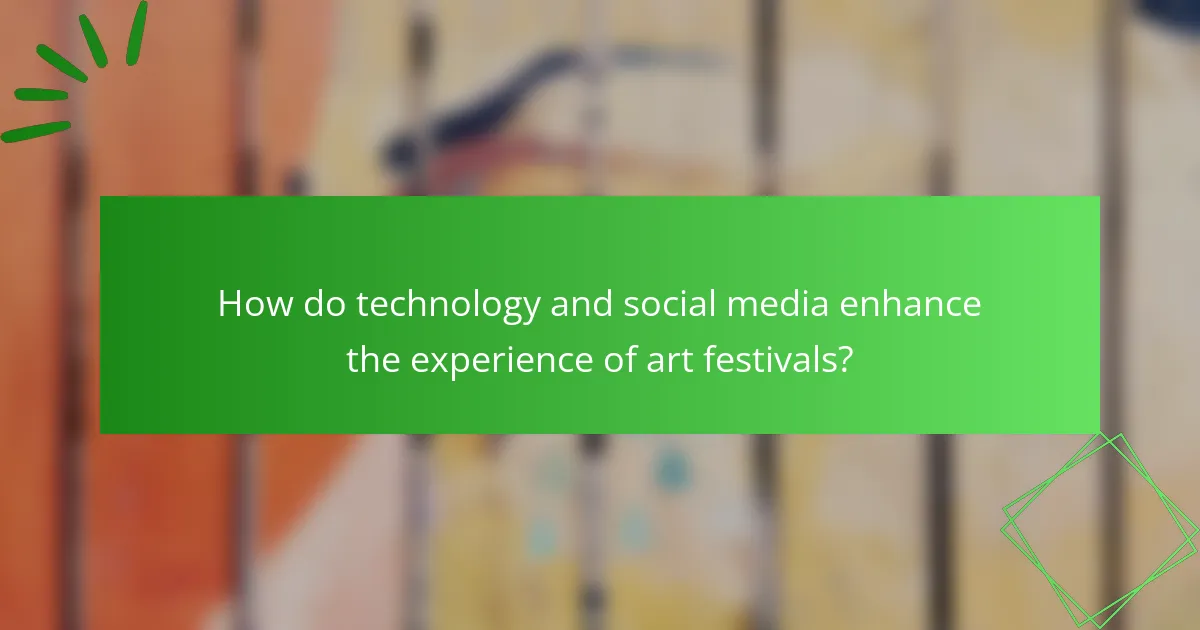
How do technology and social media enhance the experience of art festivals?
Technology and social media significantly enhance the experience of art festivals by fostering greater engagement and accessibility. These platforms allow artists to showcase their work to a global audience, breaking geographical barriers. For instance, live streaming enables real-time participation, while social media campaigns create buzz and community interaction. Additionally, augmented reality applications can transform physical art displays into immersive experiences, adding layers of interaction. The integration of technology not only amplifies visibility but also enriches the cultural exchange among diverse festival-goers, making art more inclusive and dynamic.
Which platforms are most effective for promoting global art festivals?
Social media platforms, art-focused websites, and online event platforms are most effective for promoting global art festivals.
Social media platforms like Instagram and Facebook offer visual engagement, reaching diverse audiences. Art-focused websites provide targeted outreach to art enthusiasts. Online event platforms facilitate ticket sales and event management, enhancing accessibility for global audiences.
Combining these platforms maximizes visibility and audience engagement, fostering cultural exchange through art.
How does virtual participation change the dynamics of cultural exchange?
Virtual participation enhances cultural exchange by broadening accessibility and fostering global connections. It allows diverse audiences to engage with art festivals from anywhere, breaking geographical barriers. This inclusivity promotes a richer dialogue among cultures, facilitating the sharing of unique artistic expressions. Additionally, virtual formats can include interactive elements, such as live discussions, that deepen engagement and understanding. As a result, global art festivals can reach larger audiences, creating a more dynamic cultural landscape.
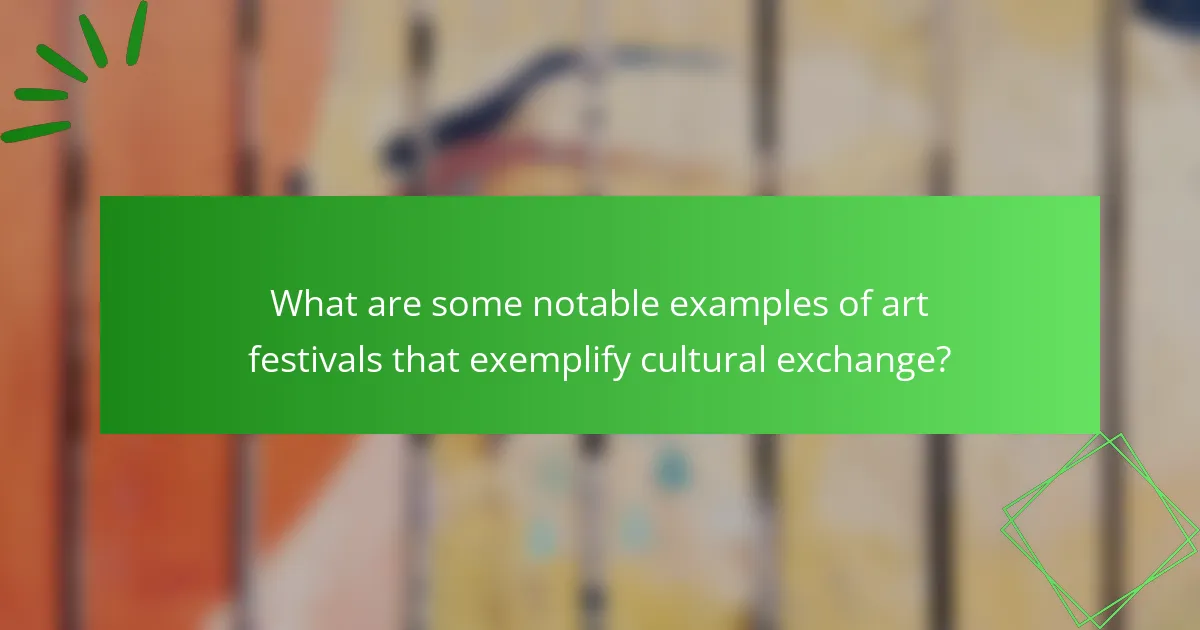
What are some notable examples of art festivals that exemplify cultural exchange?
Notable examples of art festivals that exemplify cultural exchange include the Venice Biennale, Art Basel, and the Edinburgh Festival. These festivals showcase diverse artistic expressions, foster international collaboration, and promote dialogue among cultures.
The Venice Biennale features contemporary art from around the world, highlighting unique national pavilions. Art Basel connects galleries and artists globally, emphasizing contemporary works. The Edinburgh Festival celebrates performing arts, attracting participants from various cultural backgrounds, enriching the artistic landscape.
These festivals serve as platforms for cultural dialogue, allowing artists to share their perspectives and audiences to experience varied cultural narratives. The interactions at these events lead to greater understanding and appreciation of global art forms.
Which festivals have successfully integrated diverse cultural expressions?
Global art festivals that successfully integrate diverse cultural expressions include the Edinburgh Festival Fringe, the Venice Biennale, and the Festival d’Avignon. These festivals showcase a wide range of artistic disciplines, promoting cross-cultural dialogue and understanding. For example, the Edinburgh Festival Fringe features performances from artists worldwide, fostering inclusivity. The Venice Biennale highlights contemporary art from various cultures, encouraging global artistic exchange. The Festival d’Avignon presents theater and performing arts that reflect diverse cultural narratives, enhancing cultural appreciation.
How do specific art festivals contribute to global dialogues on social issues?
Global art festivals foster global dialogues on social issues by providing platforms for diverse voices. They encourage collaboration among artists, activists, and communities, amplifying messages related to equality, climate change, and cultural identity. Festivals like the Venice Biennale showcase works that challenge societal norms and provoke critical discussions. By engaging audiences through immersive experiences, these events cultivate awareness and inspire action on pressing global issues.
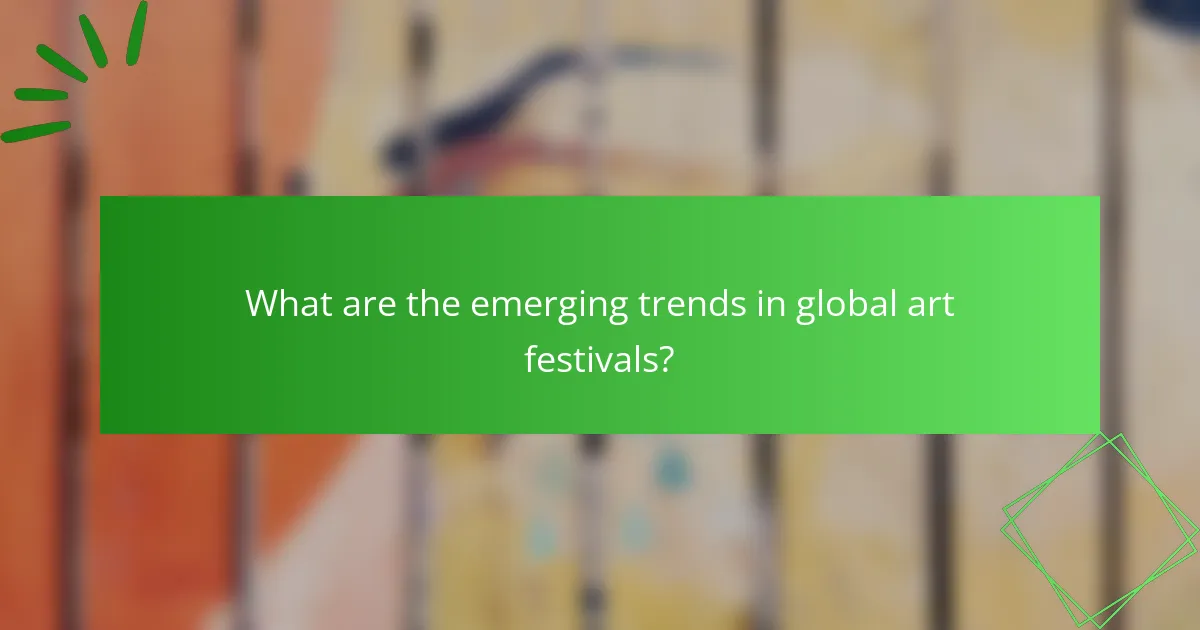
What are the emerging trends in global art festivals?
Emerging trends in global art festivals emphasize inclusivity, sustainability, and digital integration. Festivals increasingly showcase diverse voices, fostering cultural exchange and dialogue. Additionally, eco-friendly practices are becoming standard, with many events prioritizing sustainable materials and reducing waste. The rise of virtual and augmented reality experiences allows for broader audience engagement, transcending geographical limitations. These trends reflect the evolving landscape of global art festivals, enhancing their role in cultural connectivity.
How are sustainability practices being adopted in festival planning?
Sustainability practices are increasingly integrated into festival planning through eco-friendly initiatives and community engagement. Art festivals promote recycling, waste reduction, and sustainable sourcing of materials. For instance, many festivals now prioritize local artists and vendors, reducing carbon footprints associated with transportation. Additionally, festivals implement renewable energy sources, such as solar power, to minimize their environmental impact. This commitment not only enhances cultural exchange but also fosters a sense of responsibility among attendees and organizers.
Which innovative formats are gaining popularity among festival-goers?
Interactive installations and immersive experiences are gaining popularity among festival-goers. These innovative formats encourage audience participation and foster deeper connections with art. Virtual reality exhibits and augmented reality features enhance engagement and offer unique perspectives on artistic expressions. Additionally, pop-up performances and collaborative art projects create dynamic environments that reflect cultural diversity.

What are the best practices for artists and organizers at global art festivals?
Artists and organizers at global art festivals should prioritize collaboration, cultural sensitivity, and audience engagement. Effective communication fosters partnerships that enhance the festival experience. Utilizing social media promotes visibility and connects with diverse audiences.
Moreover, incorporating local artists enriches cultural exchange, showcasing unique perspectives. Providing workshops or interactive sessions encourages participation, making art accessible. Finally, evaluating feedback post-festival informs future improvements, ensuring ongoing relevance and success.
How can artists effectively engage with diverse audiences?
Artists can effectively engage with diverse audiences by participating in global art festivals that promote cultural exchange. These festivals provide platforms for artists to showcase their work to varied demographics, fostering inclusivity and dialogue.
Through interactive installations and workshops, artists can invite audience participation, enhancing engagement. Additionally, leveraging social media during these events expands reach, enabling artists to connect with global audiences beyond the physical venue.
Collaborative projects with local artists also enrich cultural understanding, allowing for the blending of different artistic traditions. This approach not only broadens the artist’s perspective but also deepens audience appreciation for diverse art forms.
By utilizing these strategies, artists can create meaningful connections, ensuring their work resonates across cultural boundaries.
What strategies should organizers implement for successful intercultural collaboration?
Organizers should implement inclusive practices, clear communication, and collaborative frameworks for successful intercultural collaboration. These strategies enhance mutual understanding and respect among diverse participants.
Inclusive practices involve inviting diverse voices and perspectives to ensure representation. Clear communication includes using accessible language and facilitating dialogue to bridge cultural gaps. Collaborative frameworks encourage shared decision-making, allowing participants to contribute actively and feel valued.
As a result, these strategies foster a sense of community and enhance the overall impact of global art festivals in promoting cultural exchange.
What common mistakes should be avoided when planning an art festival?
To avoid common mistakes when planning an art festival, focus on thorough research, clear communication, and effective budgeting. Neglecting these areas can lead to logistical issues and poor attendance.
1. Failing to define a clear theme can dilute the festival’s identity.
2. Inadequate promotion can result in low visibility and attendance.
3. Overlooking logistical details, such as permits and vendor arrangements, can cause disruptions.
4. Ignoring community engagement may alienate local artists and audiences.
5. Underestimating the budget can lead to financial shortfalls.
6. Not evaluating past festivals can prevent learning from previous successes and failures.
